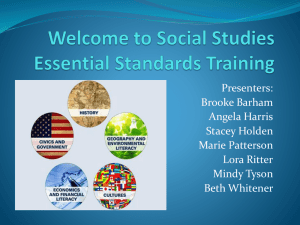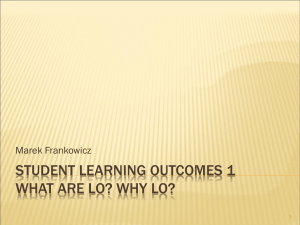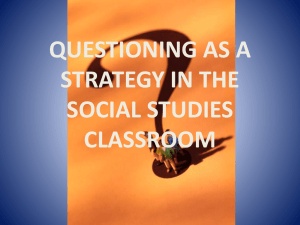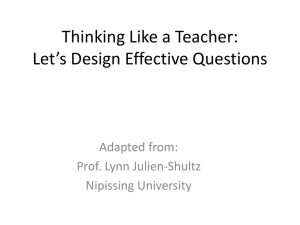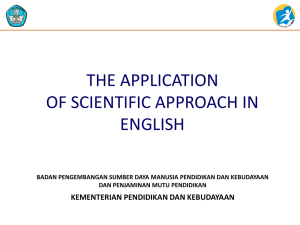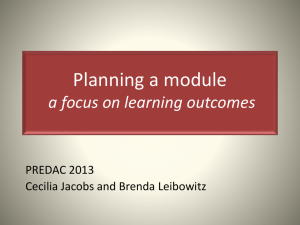Bloom`s Taxonomy A Differentiation Essential
advertisement
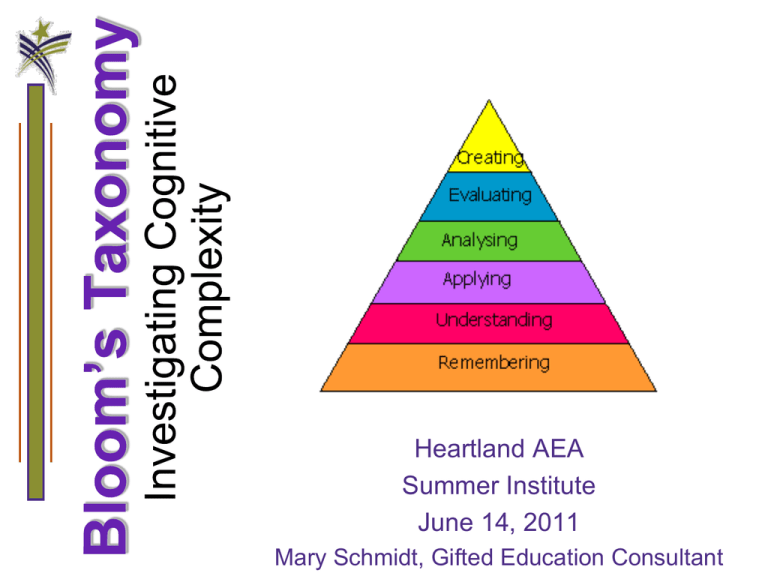
Heartland AEA Summer Institute June 14, 2011 Mary Schmidt, Gifted Education Consultant Bloom’s KUD Know 6 levels of cognitive processes of Bloom’s Revised Taxonomy 4 knowledge dimensions of Bloom’s Revised Taxonomy Understand Achieving complexity in questions and tasks is essential to deeper, more durable learning. Do Apply Bloom’s Revised Taxonomy to ICC Essential Concepts and Skills Generate questions using Bloom’s levels Higher-Order Thinking as… Transfer – Requires students not only to remember but also to make sense of and be able to use what they have learned Critical Thinking – Reasonable, reflective thinking…focused on deciding what to believe or do; “artful thinking” Problem-Solving – How to reach a desired goal when the path or solution is not readily apparent How to Assess Higher-Order Thinking Skills in Your Classroom, Susan M. Brookhart, 2010 “So, Izzy, did you ask a good question today?” Discuss in a group… 1. What makes a task, question or objective “good”? 2. Why is it important for teachers to meet these criteria in their instruction? 3. What are the consequences when they don’t? 4. What would you see and hear in a classroom where higher-order thinking and questioning are occurring? 5. What would happen to student learning if teachers and students functioned at higher-order levels? A “good” question… …makes you think. …does not have an immediate answer. …requires thinking, feeling and application to previous knowledge. …extends and clarifies a concept. …leads to another good question. …develops out of genuine curiosity or confusion. …reflects a genuine desire to find out, a deep feeling for wanting to know more than we already do. …opens doors. …demands more than a “yes” or “no” answer. ~ from Developing More Curious Minds by John Barell What are the 6 levels of Bloom’s? Original Terms ¥ Evaluation ¥ Synthesis ¥ Analysis ¥ Application Can you put them in order - low to high? ¥ Comprehension ¥ Knowledge (Based on Pohl, 2000, Revision At-a-Glance Original Terms New Terms ¥ Evaluation ¥Creating ¥ Synthesis ¥Evaluating ¥ Analysis ¥Analysing ¥ Application ¥Applying ¥ Comprehension ¥Understanding ¥ Knowledge ¥Remembering (Based on Pohl, 2000, Learning to Think, Thinking to Learn, p. 8 ) Understandings These are conceptual objectives for students that Represent big ideas that have enduring value beyond the classroom Reside at the heart of the discipline and are worthy of exploration Require “uncoverage” rather than coverage (of abstract or often misunderstood ideas) Offer potential for engaging students --Wiggins & McTighe, UbD, 1998 A student who UNDERSTANDS can… Explain it clearly, giving examples Use it Compare and contrast it with other concepts Relate it to other instances in the subject, other subjects and personal life experiences Transfer it to unfamiliar settings Discover the concept embedded within a novel problem Combine it appropriately with other understandings. Six Facets of Understanding When we truly understand we – Can explain – Can interpret – Can apply – Have perspective – Display empathy – Have self-knowledge --Tomlinson & McTighe, 2006, p. 67 TTYN What connections are you making among the concept of “understanding” and Bloom’s Taxonomy, conceptbased learning, Iowa Core, differentiation, AIW, etc.? The Knowledge Dimension Factual – Terminology – Details & Elements Conceptual – Classifications & Categories – Principles & Generalizations – Theories, Models, & Structures The Knowledge Dimension Procedural – Subject-specific skills & algorithms – Subject-specific techniques & methods – Criteria for determining when to use appropriate procedures Metacognitive – Strategic knowledge – Contextual & conditional knowledge – Self-knowledge The Taxonomy Table Modeling Example Generate criteria to judge the quality of a question and critique a given set of questions using those criteria. How it works… Generate criteria to judge the quality of a question and critique a given set of questions using those criteria . Apply S(ubject) V(erb) O(bject) format S = student (often implied) V = generate (create) V = critique (evaluate) O = criteria to judge the quality of a question O = a set of questions Think Aloud Generate criteria to judge the quality of a question and critique a given set of questions using those criteria . Science As Inquiry grades 6-8 Essential concept/skill Design and conduct different kinds of scientific investigations Detail Students use appropriate safety procedures when conducting investigations Focus on the detail Students use appropriate safety procedures when conducting investigations. At Your Table: Decide on a content area, discipline, and grade span from the IC. Chart one of the details on the Taxonomy Table. http://www.corecurriculum.iowa.gov The Man on the Moon As American astronaut Neil Armstrong set foot on the surface of the moon at 0256 GMT today, he said, “That’s one small step for man, one giant leap for mankind.” Twenty minutes earlier, Armstrong reported the lunar module’s safe landing with these words, “Houston, Tranquility Base here. The Eagle has landed.” As television cameras installed on the Eagle recorded, Armstrong spent his first few minutes on the moon taking photographs and collecting soil samples. Fellow astronaut Edwin “Buzz” Aldrin joined Armstrong at 0315 GMT. The two astronauts jumped across the landscape and collected data before planting the American flag at 0341 GMT. They also delivered a plaque with President Nixon’s signature and the following inscription: “Here men from the planet Earth first set foot upon the Moon in July 1969 AD. We came in peace for all mankind.” Interview Questions Remember Understand Apply Analyze Evaluate Create Watch an interview on Sixty Minutes or similar show. Chart the level of the questions asked by the interviewer. Is there a particular order to the questions? What is the benefit of asking higherorder interview questions? How is this evidenced in the interview you analyzed? What other higher-order questions could/should the interviewer have asked? Elementary Example Concept: attributes, geometric shapes What do these shapes have in common? Which of these shapes is not like the others? Why? Into what categories can you put the shapes? Explain your categories. Change your categories so each group has two or more common attributes. Explain. Discuss in small groups: What is the highest level of thinking required of students as they engage in this activity? Where would you chart this on the Taxonomy Table Reflecting In what ways will the lens of Bloom’s Revised Taxonomy impact Iowa Core work in your school/district? What connections do you see between Bloom’s Revised Taxonomy and conceptbased learning? Reflecting In what ways will the lens of Bloom’s Revised Taxonomy impact Iowa Core Curriculum work in your school/district? Reflecting What connections do you see between Bloom’s Revised Taxonomy and conceptbased learning? The following slides chart the level of Bloom’s for each of the questions at the beginning of the session today. One important take-away is that a lesson doesn’t need to begin with low-level questions and/or tasks. Beginning with greater cognitive complexity establishes higher expectations. What’s the Bloom’s Level? 1. What makes a task, question or objective “good”? 2. Why is it important for teachers to meet these criteria in their instruction? 3. What are the consequences when they don’t? 4. What would you see and hear in a classroom where higher-order thinking and questioning are occurring? 5. What would happen to student learning if teachers and students functioned at higher-order levels? What makes a task, question or objective “good”? Why is it important for teachers to meet these criteria in their instruction? What are the consequences when/if they don’t? What would you see and hear in a classroom where higher-order thinking and questioning are occurring? What would happen to student learning if teachers and students functioned at higherorder levels? Web Resources http://faculty.chass.ncsu.edu/slatta/hi216/learning/bloom. htm This site provides an overview and graphic of Bloom’s Revised Taxonomy. http://www.kurwongbss.eq.edu.au/thinking/Bloom/blooms .htm This is a site rich in Bloom’s Revised Taxonomy examples across subject areas. Many of the handouts you’ve seen today came from this site. http://www.uwsp.edu/education/lwilson/curric/newtaxono my.htm This site offers a side-by-side comparison of the original and revised versions of Bloom’s Taxonomy.


